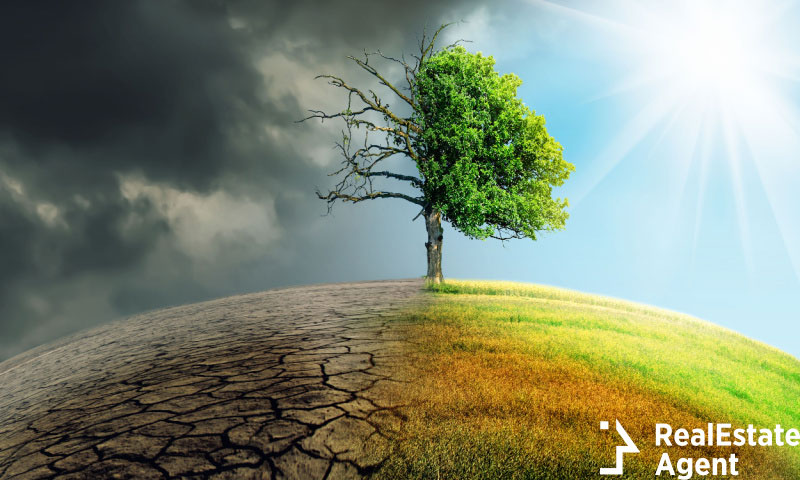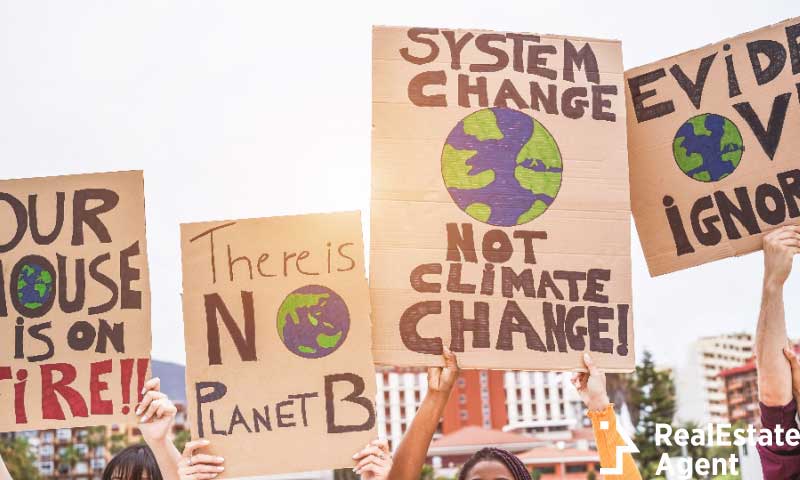Climate change is affecting the globe with extreme weather conditions. Heat waves, heavy rain, floods, and landslides are becoming more common in Europe. Other consequences are rising sea levels, ocean acidification, and biodiversity loss.
The world as we know it has been changing significantly over the past few decades. The increase in population had several consequences on Earth. Our responsibility is to take care of the planet and make it last as long as possible for us and future generations.
What is climate change, and what’s the cause?
Climate change refers to any change in climate over time, due to natural variability of the climate system or due to human activities. Since the 19th century, human activities have been the main driver of climate change, mainly due to burning fossil fuels such as coal, oil, and gas.
The leading cause of climate change is global warming, which has multiple negative consequences on physical, biological, and human systems.
Climate change can affect our health, ability to grow food, housing, safety, and jobs. Some people are more vulnerable to climate shocks. Conditions such as rising sea levels and saltwater intrusion have advanced to the point where entire communities have had to relocate.
What is net zero, and why is it important?
“Net Zero” means balancing the number of emissions produced and removed from the atmosphere to reduce global warming.
You can think of it like a bathtub; water depends on the input from the faucets and the output through the drain. If you turn on the taps, you add more water; if you take the plug out, the water comes out. To keep the water in the bathtub at the same level, ensure that the inlet and outlet are balanced.
Human production of greenhouse gases, such as carbon dioxide, is accelerating global warming. Reducing these greenhouse gas emissions is essential for preventing catastrophic climate change. Today the Earth is already 33.98°F warmer than it was at the end of the 19th century, and emissions continue to rise. To keep global warming below 34.7°F, emissions need to be cut by 45% by 2030. Governments have agreed to achieve net zero emissions by 2050 as part of the Paris Agreement, signed in 2016.
How can it be achieved?
Transitioning to a net-zero world is one of humanity’s most significant challenges. It requires a complete transformation of how we produce, consume and move. It is the key to avoiding the worst impacts of climate change. The energy sector accounts for three-quarters of greenhouse gas emissions. Replacing gas and oil with renewable energy sources can reduce emissions of CO2.
Reaching net-zero emissions will need significant changes in U.S. energy production. It will also increase the removal of greenhouse gases from the atmosphere. The most viable path to net zero emissions involves four main strategies:
Remove carbon dioxide from the atmosphere.
Net zero can only be achieved by removing carbon from the atmosphere and reducing the amount produced. Planting trees that absorb and store carbon is easy. Other methods include carbon capture and storage, which takes carbon emissions from the air and stores them in the soil.
Improving energy efficiency in buildings
Improving buildings’ energy will also impact achieving net zero. In the U.K., this means removing carbon from heating. Other countries will look into issues like air conditioning, depending on the climate. Alternative energy sources can help with these problems. Factors such as improved insulation and energy efficiency in buildings.
Electricity-powered vehicles
Transport is the most significant source of greenhouse gas emissions. Transport emissions can be reduced by being lightweight. Replacing gasoline and diesel with electric cars shows transportation can be environmentally friendly.
Power decarbonization
Energy decarbonization requires greater adoption of renewable and clean energy sources. For Great Britain, this involves the use of wind energy. The U.K. has 8GW of offshore wind capacity, but it is estimated that this will need to increase by 5-10GW per year for the next 30 years.
The difference between these approaches is that the first aims to reduce the existing amount of greenhouse gases through air capture or reforestation. In contrast, the other three aim to reduce or offset the number of greenhouse gases produced.
Who is part of net zero?
The term “net zero” refers to reducing total greenhouse gas emissions to zero as far as possible, either by reducing or offsetting emissions with equivalent carbon removals.
Setting goals is the easiest step toward carbon neutrality. But the real challenge is strengthening that goal and making progress towards it. For this reason, it is essential to consider the extent to which countries are committed to carbon neutrality.
Most countries have set targets or committed to net zero emissions on timescales compatible with the Paris Agreement temperature goals. The UK, Germany, Spain, France, Denmark, Norway, Portugal, Switzerland, The U.S., New Zeeland, and Chile are those countries. Costa Rica, Sweden, Iceland, Austria, and Finland are set to be part of net zero in the upcoming years. Surprisingly, Norway is the most poised to reach net zero by 2050, despite operating as one of the world’s largest gas and oil exporters.
A net zero economy
A net-zero policy requires extensive behavioral changes and heavy investment to transform the global industrial system. Thus, to address these challenges, we need a common purpose. Starting by moving away from the current “disastrous” narrative and focusing on the opportunities and rewards created by decarbonizing the economy.
Protecting the environment for future generations also helps broader economic prosperity. Achieving net-zero emissions requires moving away from fossil fuels and investing in future clean technologies. The economy is growing. Some sectors will benefit while others will decline, such as oil and gas production. Achieving net-zero emissions will reduce the risks of climate change and the associated negative economic impacts.
Transitioning to a low-carbon economy presents undeniable opportunities for companies contributing to climate change mitigation and adaptation.
Capital flows finance the technological advances necessary to make net zero a reality. Creating millions of new jobs and increasing global economic growth. The rapid growth of green bonds and loans is an excellent opportunity for companies to reduce capital costs and finance their transition. Sustainable investing is becoming more mainstream.
Companies looking to reach a net zero goal must take a multi-pronged approach. They need to reduce carbon emissions from operations, manage internal and supply chain reductions, and offset hard-to-avoid emissions in the short term. This starts with accurate data: to reduce emissions, you first need to understand them.
How does it impact the future?
There are several benefits to the planet as a whole. Not only from an environmental point of view but also from an economic and social point of view, governance, health, and more.
A lower level of global poverty.
Reducing carbon emissions also contributes to decreasing the average global temperature. Reducing fires and floods that destroy regions leads to the advance of world poverty. With the adoption of Net Zero, the quality of life of entire populations can be improved.
Healthier lifestyle.
There is greater adherence to conscious consumption, without wasting food, and non-polluting transport options, among others. The more companies adhere to Net Zero, the greater the changes in the lifestyle of humanity.
More remarkable preservation of Fauna and Flora.
A 35.6°F increase in the global average temperature would result in the extinction of 99% of the planet’s coral reefs and 16% of the plants. Animals that maintain a food chain relationship with these biomes would also die. By adhering to Net Zero and reducing liquid carbon emissions, fauna and flora are also saved.
Lower risk of respiratory problems and skin cancer.
One of the consequences of global warming on human health is the increased risk of respiratory problems. Asthma, pneumonia, lung cancer, and bronchitis are some of them. The ozone layer is also affected by a more significant liquid carbon emission. Ultraviolet radiation reaches the Earth, increasing the risk of skin cancer. The Earth’s natural protection and air quality improve with lower carbon concentration. Respiratory tract irritation, lung damage, and even some types of cancer are avoided.
Lower obesity, malnutrition, and fewer illnesses.
Climate changes caused by exaggerated carbon emissions negatively affect food production and life. There is less availability of natural food and the population of insects increases. Remember that more insects can result in more use of pesticides in food. This can lead to food poisoning and more searches for processed foods. Promoting carbon reduction makes it possible to fight against diseases linked to the absence of food, like malnutrition and obesity. It can also prevent diseases spread by insects, such as Malaria, Zika, and Chagas disease, among others.
Some scientists are skeptical about the promise of Net Zero. They question the feasibility of capturing the number of carbon emissions to achieve neutrality in 2050. Reaching net carbon emissions by 2050 will not be possible globally. Or it will not be enough to keep temperatures below 35.6°F compared to the temperature of the pre-industrial era. The technological solutions proposed need to be revised because of their need for high costs or technical impossibility.
Conclusion
The global Net Zero goal may need to be revised. It may be insufficient to keep the temperature below 35.6°F. Business and investment plans must take advantage of the opportunities that arise in this transition. At the same time, if there is still skepticism about climate change, the market adjustments will generate risks that can be mitigated in time. Without a doubt, the next five years will be decisive for investors who want to be relevant in the most ambitious transition of humanity.
We would love to hear your opinion on this concerning topic for everyone searching for a solution. Feel free to leave your opinion in the comment section.















